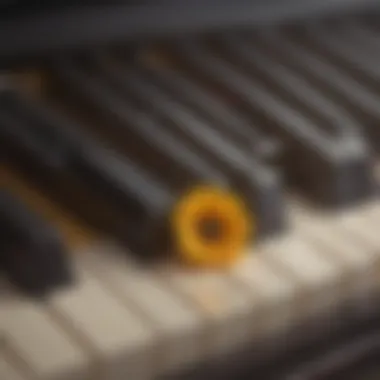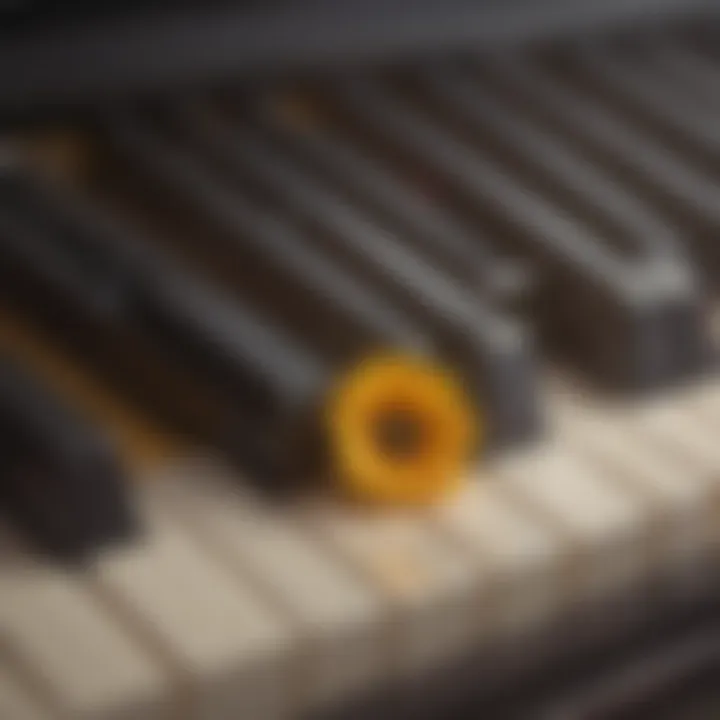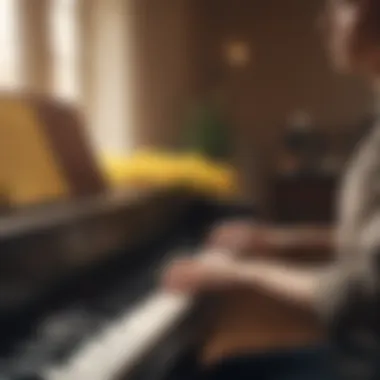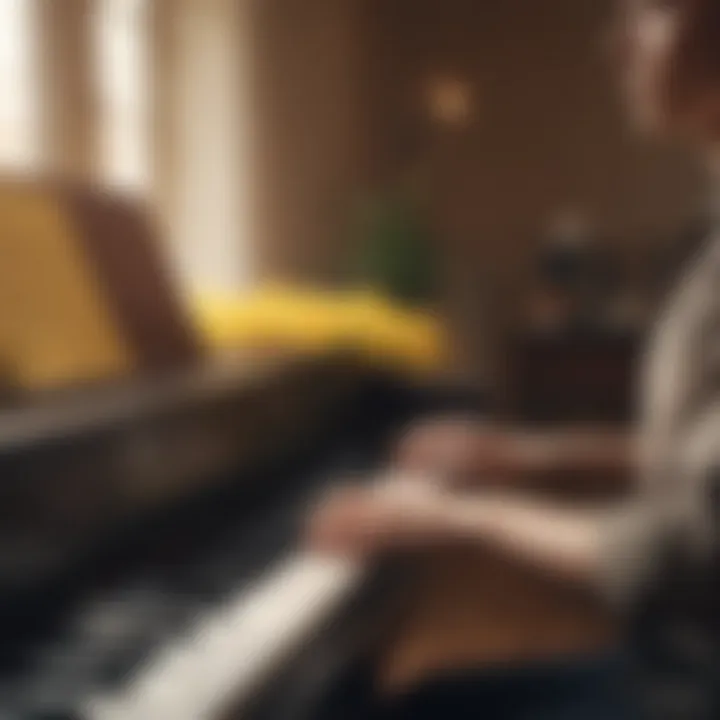Mastering 'You Are My Sunshine' on Piano: A Complete Guide


Intro
The song "You Are My Sunshine" evokes a sense of nostalgia and warmth, wrapping listeners in its embrace. It’s not just a simple tune; it resonates deeply with emotions tethered to love, longing, and companionship. Learning to play it on the piano can not only sharpen your musical skills but also allow you to convey the essence of those feelings through each note. In this guide, we shall embark on a journey that takes you through its historical roots, musical composition, and practical steps to master this beloved classic.
Artist Profile
Biography and Background
Traditionally, the song's origins can be traced back to the early 20th century. It’s often credited to the smiles of many who sang it on porches, but the precise authorship remains somewhat murky. The most widely accepted version attributes it to the Louisiana-born singer and songwriter Jimmie Davis. Born in 1899, he was not just a musician but also served as a governor, blending governance with his love for music. His childhood in the South undoubtedly influenced both his songwriting and the cultural impact of this particular piece.
Major Influences and Inspirations
Davis was shaped by the sounds around him. From folk traditions to blues influences, his upbringing in a rural environment infused his music with authenticity. The simplicity found in country music allowed him to express complex feelings in a straightforward manner. As a pianist, one could imagine those very elements playing a significant role in creating the rich, yet accessible melody we adore today.
Song Analysis
Theme and Lyrics Breakdown
"You Are My Sunshine" delivers a poignant message wrapped in simplicity. The lyrics reflect a deep emotional connection, using love and loss as their central themes. Take a moment to consider this line:
"You make me happy when skies are gray."
Such a sentiment encapsulates the essence of joy against adversity. The choice of words is relatable, as many have felt that one person in their life brings light even on the darkest days. This universal appeal is likely a key reason why the song has stood the test of time.
Instrumentation and Composition
In terms of its musicality, the piece can be characterized by its gentle melody and straightforward chord progressions. Typically set in the key of C major, the abundance of whole and half steps creates a sense of familiarity:
- C major
- F major
- G major
These chords are fundamental for beginners, allowing for an easy starting point. The left hand primarily plays root notes or simple bass lines, while the right hand interacts with the melody. This combination beautifully showcases the idea of harmony, creating depth without overwhelming complexity.
When practicing, focus on transitioning smoothly between these chords. It's like walking - once you’ve found your rhythm, it all falls into place.
Closure
Understanding the layers behind "You Are My Sunshine" adds a different-dimensional flavor to the experience of playing it. From its poignant themes to its straightforward yet melodic composition, mastering this classic song isn't just about hitting the right keys. It’s about channeling the emotion imbued within it and sharing that warmth with others. So, as you dive into practice, remember to savor each note, allowing the melody to evolve as you do.
Preface to 'You Are My Sunshine'
In the vast panorama of American music, few songs manage to evoke feelings as warm and nostalgic as "You Are My Sunshine." This beloved tune transcends generations, holding a special place in many hearts. Its simple yet profound melody beckons musicians, both budding and seasoned, to explore its depths on the piano. Understanding this piece is not merely about following notes but rather diving into the rich tapestry of its history and significance.
The emergence of this song is tightly intertwined with the cultural landscape of America, making it an important subject for any piano student. Its interplay of simplicity and emotional weight teaches invaluable lessons in expression. When you play it, you don't just engage with the music; you connect with what it means to countless people.
By mastering this song, musicians gain more than technical skills; they acquire an emotional tool that resonates with listeners. This guide aims to offer insights into both the foundational elements and the emotional layers of "You Are My Sunshine."
Historical Context of the Song
Origins and Composition
The roots of "You Are My Sunshine" can be traced back to the early 20th century, steeped in the tradition of folk music. The song's origins are somewhat clouded, with various claims regarding its authorship. While some sources attribute the song to the Pine Ridge Boys or even Jimmie Davis, the real charm lies in its collective ownership by the people who sing it. This characteristic serves as a powerful reminder that great music often comes from communal experiences rather than a solitary genius.
What sets the composition apart is its accessibility. The chord progressions, primarily revolving around major keys with a few minors, mirror the uplifting spirit of the lyrics—it's an unmistakable favorite among beginners and seasoned pianists alike. This simplicity is a double-edged sword; while it encourages those new to music, it can offer less challenge to the more advanced musicians.
Influence on American Music
The impact of "You Are My Sunshine" cannot be overstated. Its incorporation into the fabric of American culture has earned it a revered position in the world of musical storytelling. This song embodies a unique blend of country, folk, and pop influences, making it a versatile piece that has been adopted by countless artists in various genres. Its infectious melody invites even the most hesitant singers to join in, effectively fostering a sense of community—a vital element in American music history.
While its straightforward structure serves as a launching pad for budding musicians, its emotional depth allows seasoned artists to explore new interpretations. In this way, it exemplifies how music can evolve while retaining its core essence.
Versions and Covers by Various Artists
Over the decades, "You Are My Sunshine" has seen a myriad of interpretations, bringing a fresh perspective to the original melody. Artists like Johnny Cash and the late, great Ray Charles have anchored their versions in soulful renditions that add layers of emotion. Each cover showcases the song's remarkable adaptability and the way it resonates with different audiences.
This plethora of interpretations highlights a fascinating characteristic of music—its ability to transform. While each version retains the song's hallmark simplicity, choice of instrumentation or vocal style introduces unique flavors. This variety works to the advantage of aspiring musicians; as they listen and analyze these variants, they not only learn about different techniques but also how to inject personal elements into their own performances, fostering a deeper connection to the music.
Significance in Popular Culture
Usage in Film and Television
From folk gatherings to the silver screen, "You Are My Sunshine" has earned its place in various forms of media. The song's ability to evoke feelings makes it a favorite choice for filmmakers. It's often used to symbolize love, loss, and nostalgia. Its melodies can uplift scenes or add gravitas to moments of reflection, enhancing the emotional undercurrent.
Its recurrent appearances have planted it firmly in the viewer's memory, making it synonymous with heartwarming or poignant moments. Consequently, this recognition can encourage budding musicians to learn the piece, knowing it has a familiar flavor to audiences both young and old.
Cultural References and Impact
The resonance of "You Are My Sunshine" stretches beyond just music. It's been referenced in various cultural touchstones—from literature to memes—essentially making it a cultural shorthand for joy and unfiltered affection. When something becomes so widely recognized, it often reflects not just artistic merit but also how deeply it resonates with societal themes.
These cultural references serve as powerful tools for a piano learner; knowing a song is both a musical piece and also embedded within the social context amplifies one's appreciation and understanding of its significance.
Emotional Resonance with Audiences
Perhaps the most striking feature of "You Are My Sunshine" is its emotional impact. Its lyrics capture a universal feeling—longing for connection and love—which resonates with a wide audience. This song has the remarkable ability to evoke memories, create a sense of warmth, and stir emotions. Whether sung at a family gathering or played during a moment of solitude, it brings forth a wave of sentiment.
The emotional core can inspire interpreters to go beyond mechanical playing. It encourages a more profound exploration of dynamics and nuances, ensuring that performers not only learn the notes but also deliver an emotional experience. This investment in emotion makes practicing the piece essential; it leads to more fulfilling performances, one that transcends mere technicality to reach the hearts of listeners.


Understanding the Structure of the Piece
Understanding the structure of "You Are My Sunshine" is essential for anyone looking to play this beloved song on the piano. Grasping the framework not only allows musicians to navigate chords and melodies but also paves the way for a richer interpretation. More often than not, the song's simple yet effective chord progressions and melodic lines serve as a vehicle for emotional expression. Hence, diving into the nuts and bolts of this arrangement can enhance your playing experience significantly.
Basic Chord Progressions
Identifying Major and Minor Chords
Identifying major and minor chords is a fundamental skill when learning to play any song, and "You Are My Sunshine" illustrates this beautifully. Major chords often evoke a sense of happiness and brightness, while minor chords can introduce a tone of melancholy. For instance, the song primarily revolves around C major and A minor chords. This straightforward pairing creates a backdrop that is both familiar and comforting. Knowing how to spot these chords not only benefits beginners but also simplifies the learning process for more experienced players looking to brush up on their skills.
- When you strike a major chord, it creates a happy sound, a characteristic that can uplift the mood.
- Conversely, minor chords bring a softer touch, allowing for emotional depth without complexity.
With this understanding, you can appreciate the emotional impact of each chord and how they work together to support the melody.
Common Progressions in 'You Are My Sunshine'
The common progressions found in "You Are My Sunshine" play a pivotal role in shaping the song's character. The most recognizable progression in this piece is I-IV-V, which translates to C-F-G in the key of C major. This progression is not just popular; it's a classic choice in many songs across genres. Its predictability gives it a comforting quality, making it easy for listeners to grasp the emotional feel of the song.
- Songs utilizing these progressions often have a catchy quality, facilitating ease of recall.
- However, the simplicity can sometimes lead to predictability. A balance must be struck to keep it engaging ideally.
Utilizing this progression enables players to feel connected to a rich musical history, reinforcing why this song resonates so deeply with audiences.
How Chords Shape the Melody
The interplay between chords and melody in "You Are My Sunshine" cannot be overstated. Chords shape the melody in a way that underlines the emotional narrative of the lyrics. The melody typically sits atop the chordal structure, allowing performers to express both the lyrical content and musical phrasing effectively. This relationship is crucial as it gives the performer a framework to work within while allowing for personal interpretation.
- For example, playing the melody against a set of major chords can instill a sense of joy, while altering it slightly with minor chords changes the whole vibe.
- This flexibility is advantageous as it allows skilled players to experiment with their interpretations while remaining grounded in the song’s original essence.
Exploring how chords shape melody enriches one's overall understanding of music composition and enhances a musician's ability to craft their unique interpretation.
Melodic Elements
Analyzing the Melody Line
Analyzing the melody line of "You Are My Sunshine" provides valuable insights into how musical elements coalesce to evoke strong feelings. The melody itself has a singable quality, flowing gently while capturing the heart of the lyrics. Comprehending this melody line is essential as it serves as the foundation for musical expression within the piece.
- The straightforward phrasing makes it accessible for beginners, while its charm is evident enough to engage experienced musicians.
- Still, simplicity doesn't detract from the emotional depth; it enables interpreters to zero in on the subtleties of each note.
Articulating this melody with precision is as important as understanding its structure, as it will shape how effectively you convey the song's emotional undertones.
Intervals and Their Importance
Intervals are the building blocks of melody, and their significance in "You Are My Sunshine" cannot be overlooked. The song employs primarily second and third intervals, which create a harmonious relationship between notes. Understanding intervals helps musicians not only to learn melodies more quickly but also to appreciate the nuances that each note carries.
- Utilizing a variety of intervals keeps the musical line engaging while maintaining the signature sound of folk music.
- Nevertheless, focusing solely on intervals can sometimes lead to overlooking other elements such as dynamics and stylistic expression.
Recognizing and mastering these intervals molds a player's ability to interpret melodies, ultimately enhancing the performance quality.
Rhythmic Patterns Present in the Song
Rhythmic patterns add yet another layer to the performance of "You Are My Sunshine." The song is characterized by a lilting rhythm that feels conversational, perfectly matching the lyrical storytelling aspect. It invites both listeners and players to become emotionally invested in the narrative.
- The syncopated rhythm, blended with steady beats, offers an inviting quality that often resonates well with audiences.
- However, achieving this rhythmically without overthinking or forcing can be a challenge, especially for novice pianists.
Understanding these rhythmic elements allows performers to bring the song to life, as rhythm is the heartbeat of music that drives emotional connection.
Setting Up to Play
Setting up to play is one of those bits that may seem trivial at first, but the right preparation can make or break your experience with the piano. Think of it like buttering toast; you can’t just slap it on and hope for the best. You need to know the type of piano you are leaning on, your techniques, and how to keep your comfort when your fingers are dancing over those keys.
Getting started with ‘You Are My Sunshine’ requires a solid setup. This makes learning easier and helps you avoid the aches and pains that can occur from improper technique.
Choosing the Right Piano
Acoustic vs. Digital Pianos
When choosing between acoustic and digital pianos, it’s essential to understand your goals. Acoustic pianos have that rich sound and are generally favored by purists. You’ll notice that their action (the way the keys respond) provides a unique touch that many beginners find appealing. However, digital pianos have advanced quite a bit over the years. They often come packed with features like recording capabilities, metronome settings, and even hundreds of sounds. This flexibility can be a game-changer for new players trying to learn ‘You Are My Sunshine’. The choice hinges on what you value more—the experience of the natural sound or the modern conveniences of digital technology.
Features to Consider for Beginners
For those just starting out, there are several critical features to think about. First up is the weighted keys. They give a more authentic feel, mimicking the resistance of an acoustic piano. Another feature is the polyphony count; a higher number means you can play more notes at once without dropping sounds, which can be handy when tackling more complex pieces. And don’t forget about portability. If you plan to move your piano around, that’s something to keep in mind. Beginners appreciate having a platform that can grow with them, offering adaptability as skills improve.
Recommended Models for Learning
For those curious about specific pianos, popular models for beginners include the Yamaha P-45 and the Casio Privia PX-160. Both provide weighted keys and a variety of voices to experiment with, making them excellent choices for playing ‘You Are My Sunshine’. These models are user-friendly, and the sound quality often impresses even those with more experience. Investing in a good model not only aids in learning but ensures you’ll enjoy playing for years to come.
Basic Piano Techniques
Proper Hand Positioning
Hand positioning might feel like a minor detail, but it can be critical for performance and ease of playing. The hands should curve gently above the keys, fingers relaxed but ready to leap. Imagine your fingers as springs; they need just the right tension to bounce back without getting too tight. Maintaining proper positioning helps keep repetition injuries at bay and allows for smoother transitions as you move between notes, especially important for a sweet melody like ‘You Are My Sunshine’.
Finger Techniques for Beginners
Finger techniques is where fascination meets practicality. Using all five fingers correctly is vital. One effective method is practicing scales in different keys, which not only improves finger agility but also builds muscle memory. Playing softly with one hand while practicing finger placement with the other can also do wonders in building coordination. The idea is to develop a natural fluidity that will carry over as you tackle more complex pieces in your repertoire.
Finding Comfort and Avoiding Strain


Finding comfort while playing is all about being mindful of your posture and hand positioning. Slouching or gripping too tightly is a quick ticket to discomfort. Make it a habit to take regular breaks when practicing to avoid finger fatigue. Position your bench at a height that feels good; your forearms should be parallel to the ground. Getting this right will let you feel at ease while you play your way through the gentle notes of ‘You Are My Sunshine’.
In summary, every little aspect counts when setting up to play the piano. From choosing the right instrument to mastering techniques, every element works together to enhance your overall experience and skill development.
Step-by-Step Guide to Playing 'You Are My Sunshine'
Navigating the world of music can feel like a labyrinth at times; however, breaking down the process into manageable steps makes the journey more approachable. This section focuses on providing a systematic method to learn 'You Are My Sunshine', which is not only beneficial for grasping the piece but also nurturing one's overall piano skills. By concentrating on both the right and left hands separately before combining them, you lay down a strong foundation. This section emphasizes practical techniques and methods that can lead to a satisfying mastery of the song.
Learning the Right Hand Melody
B breaking Down the Melody Notes
When you start with the melody in your right hand, it’s crucial to really unpack those notes. The first step is identifying each note and its corresponding key on the piano. This serves as a framework for your melody. What's important here is that by isolating the melody, you allow yourself to focus on accuracy and expression without the distraction of harmony. The primary feature of breaking down the melody is simplicity; it allows the player to progress at their own pace.
Utilizing a visual aid, like sheet music or a simple notation, can be invaluable. By repeating segments until they're second nature, you naturally build muscle memory, a key factor for any budding pianist. However, practicing too long without breaks could lead to fatigue, so be mindful of your hands.
Practicing with a Metronome
Practicing with a metronome is akin to having your personal drumbeat, guiding you through the rhythm. This consistent tick fosters a sense of timing that’s often overlooked in initial practice stages. In the context of ‘You Are My Sunshine’, where the tempo can define its emotional impact, using a metronome becomes essential.
The beauty of a metronome is that it helps maintain a steady tempo, offering the chance to master the rhythm before injecting speed. Of course, it's easy to be lulled into a reliance on technology, so ensure that you also practice without it to develop your internal sense of timing. The use of a metronome is particularly popular among beginners because it provides structured practice while also enhancing rhythmical dexterity over time.
Incorporating Dynamics into Your Playing
The emotional depth of any piece is often highlighted through dynamics—the variations in loudness and softness. For 'You Are My Sunshine', dynamics can evoke the feeling of sunshine breaking through clouds. Focusing on dynamics when practicing can turn a basic note sequence into a heartfelt rendition.
By varying your touch on the keys, you can create a more engaging performance. For example, playing certain notes softly can suggest tenderness and nostalgia, while louder notes could imply a burst of joy. The key characteristic of this approach is its interpretative power, making it not just about playing the notes but conveying emotion as well.
Since dynamics can be subtle, recording yourself can help in identifying areas in need of adjustment. As a side note, however, it requires discipline to avoid over-exaggeration in volume shifts, which could detract from the song’s overall flow.
Integrating the Left Hand Harmony
Finding the Correct Bass Notes
Playing the left hand adds a complimentary layer to the melody. Finding the right bass notes can feel akin to finding the roots of a plant; they help hold everything together. The left hand typically plays the harmony, which, in 'You Are My Sunshine', supports the melody beautifully. Focus on identifying the bass notes corresponding to the chords used in the melody. This aspect of playing is fundamental in creating depth and richness within the piece.
When you practice playing bass lines, you are essentially providing a foundation that enhances the melody’s overall sound. Moreover, it gives you an understanding of chord progressions that can cross over to other pieces, broadening your musical repertoire. While initially challenging for some, regular practice will yield a more confident left-hand execution.
Combining with Right Hand Melody
Once you’re comfortable with both hands separately, the magic happens when you combine them. This integration is the moment where the melody meets harmony, and the piece truly comes alive. The core aspect of combining these elements is synchronization; learning to hear and feel how the left and right hands interact is vital.
For 'You Are My Sunshine', maintaining balance is key—neither hand should overpower the other. A common strategy is to start slow, allowing each note to align seamlessly. Playing together creatively challenges your coordination, pushing you to develop your skills even further. It’s essential to be patient with yourself during this process; every pianist has been there.
Creating a Balanced Sound
Creating a balanced sound mixes melodious notes and robust harmonic structures. Like a well-brewed cup of coffee, where each ingredient blends perfectly, balance makes the performance even more enchanting. In 'You Are My Sunshine', achieving balance involves figuring out how to play notes loudly or softly depending on their context within each measure.
Paying attention to how both hands can work in harmony lets the audience immerse themselves into a smoother auditory experience. One’s goal should not be just playing the right notes but conveying the intended emotion behind them as well. Ensure that you revisit sections where your left hand might be competing too loudly against the melody, making adjustments as necessary for a more unified sound.
Employing these strategies helps craft a beautiful rendition of 'You Are My Sunshine', setting the stage for deeper expression in your musical journey.
Interpretation and Expression
Understanding how to interpret and express a song like 'You Are My Sunshine' isn’t just about hitting the right notes—it's about conveying the story embedded in the music. This piece, characterized by its poignant lyrics and heartwarming melody, requires players to connect emotionally with what they're playing. The process of interpretation involves deciding how to make the song resonate with both the player and the audience. Expressing this through dynamics, phrasing, and even nuances in tempo can turn a simple rendition into a powerful performance that lingers in the hearts of listeners.
Understanding the Emotional Content
Exploring the Song's Themes
At the heart of 'You Are My Sunshine' lies a profound theme of love and longing. The lyrics reflect a narrative of emotional attachment and sorrow, evoking memories of affection. This heartfelt connection serves as the driving force behind the song's enduring popularity. When interpreting this theme musically, one can draw on various elements—such as chord selections or melodic emphasis—that highlight these feelings. This emotional depth turns it into a favorite for countless performers who wish to express their sentiments.
Unique features of exploring the song's themes include the ability to infuse personal experiences into the performance. A player might find that certain notes or dynamic levels evoke specific memories, allowing for a richer interpretation. However, one must be cautious of overdoing it. A delicate balance is needed to prevent the performance from feeling cluttered or heavy-handed, which can diminish the song’s natural beauty.
Expressing Emotion through Dynamics
Dynamics play a pivotal role in musical expression, enabling the player to communicate the song's emotional peaks and troughs. In 'You Are My Sunshine,' the contrast between loud and soft passages can parallel the lyrics, which oscillate between joy and melancholy. Thoughtfully employing different dynamics enables a richer storytelling experience. Players should experiment with crescendos and diminuendos to parallel shifting emotional content.
A key characteristic of dynamics is their ability to transform a straightforward playing style into one that showcases nuanced emotions. For instance, a soft phrase can lend a sense of intimacy, while a sudden loud passage can introduce tension or excitement. The downside, however, is the potential for inconsistency. Without careful practice, sudden alterations in volume might come off as disjointed, which could alienate listeners rather than engaging them.
Interpreting the Lyrics Musically
Bringing the lyrics of 'You Are My Sunshine' into your performance musically is a matter of aligning melody and phrasing with the emotional message of the words. Each line of the lyrics can dictate how one chooses to approach the corresponding musical motif. This relationship can yield a performance that feels cohesive and thoughtfully constructed.
The beauty of interpreting lyrics musically lies in its capacity to infuse a personal touch into the performance. By directly correlating melodic emphasis with lyrical significance, it allows performers to create distinct moments within the song. However, the challenge arises when the performer becomes too rigid about the lyrics, potentially stifling musical spontaneity. Remaining open to interpretative shifts in the moment is vital for a compelling performance.
Techniques for Personalizing Your Performance
Personalizing a performance not only highlights a player's individuality but also creates a unique listening experience for an audience. Adding personal elements like ornamentation, changes in tempo, or stylistic choices can transform a standard rendition into one that speaks volumes about the player’s vision.
Adding Ornamentation
Ornamentation provides a chance to infuse character into one's playing. This can involve adding trills, grace notes, or slides that capture the spirit of the song while introducing personal flair. These embellishments can help to elevate the overall rendition, providing a fresh twist that resonates with both the player and the audience.
A notable characteristic of ornamentation is its versatility; depending on the arrangement, it can either enhance certain sections or provide unexpected beauty within a more repetitive melody. However, one must tread lightly, as excessive ornamentation can muddle the central melody rather than enrich it, leading to confusion rather than clarity.


Experimenting with Tempo
Tempo adjustments can significantly affect the emotional impact of a performance. By varying the tempo—whether by speeding up during a more upbeat section or slowing down when expressing longing—performers can guide listeners through the emotional landscape of the song. This subtle manipulation serves as a tool to breathe life into the music.
Experimenting with tempo is particularly beneficial as it creates room for creative expression; it allows the musician to tailor the song to their feelings at any given moment. However, frequent changes or erratic shifts in tempo might disorient both the performer and audience. Consistency in maintaining an underlying feel is crucial to prevent the performance from becoming overly complicated.
Creating Your Unique Style
Developing a personal style is essential in making any performance stand out. This is where players can truly embed their signature touch in a piece like 'You Are My Sunshine.' Whether it's through a distinctive way of interpreting passages or choosing a specific arrangement that speaks to their soul, the goal should always involve making the performance uniquely theirs.
A key advantage of creating a unique style is that it allows players to express themselves freely, cultivating a signature sound that can be instantly recognizable. On the flip side, straying too far from the original composition can sometimes lead to a loss of the song's core essence. It's important to find that sweet spot where originality meets respect for the classic, ensuring that the soul of 'You Are My Sunshine' shines through while adding a personal touch.
Practice Strategies
Mastering the piano piece "You Are My Sunshine" requires not just talent but also effective practice strategies. These strategies help to break down complex skills into manageable parts, ensuring that learners gain confidence and proficiency over time. The thoughtful application of practice strategies can significantly enhance a musician's ability, particularly for those just starting out.
Breaking Down the Learning Process
Chunking Sections for Ease of Learning
Chunking involves dividing the song into smaller, more manageable sections. This method allows pianists to focus on one part of the melody or harmony at a time, rather than feeling overwhelmed by the entire piece. By isolating tricky sections, a player can dedicate time to refining specific areas of the composition. This is especially useful for beginners who might struggle with the flow of the song if they try to learn it all at once.
The key characteristic of chunking is its practicality. Each section can be practiced repeatedly until it feels comfortable, promoting a sense of accomplishment. This approach is popular for its effectiveness in muscle memory development, essential in piano playing. The standout feature of chunking lies in its ability to reduce frustration by preventing information overload. One disadvantage might be that learners could develop an attachment to sections, making it hard to connect them into a cohesive whole. However, with patience, this can be overcome.
Establishing a Consistent Practice Routine
Creating a consistent practice routine is another cornerstone of effective learning. Regular practice not only strengthens technique but also builds an overall musicality. When aiming to learn "You Are My Sunshine," dedicating specific times in the week to practice can illuminate progress pathways. An effective practice routine provides structure, which can be highly beneficial for beginners who might not yet have an established practice discipline.
The primary advantage of a consistent routine is that it fosters reliability in skills—and skills build upon themselves. It serves as a framework to help track progress. However, the unique feature of a structured approach lies in the flexibility it offers. Pianists can allocate more time to challenging areas when needed while maintaining momentum in easier sections. One downside might be potential monotony; if the routine lacks variation, interest can wane. Thus, it's essential to mix in different pieces or practice methods from time to time.
Tracking Your Progress Over Time
The act of tracking progress serves as both motivation and reinforcement for learners. Documenting small milestones creates tangible evidence of improvement, whether it's mastering a line of music or achieving a certain tempo. This strategy ensures that musicians remain engaged and aware of how far they have come.
Highlighting achievements is crucial; it allows players to celebrate victories, however small they may seem. Keeping a journal or using digital tools to log practice time and difficulties can help maintain focus and encourage perseverance. Among the advantages is the clear visual of progress over time, which can uplift spirits during challenging phases. On the flip side, a potential downside may be feelings of pressure if one focuses solely on achievements without recognition of the learning journey itself.
Utilizing Resources for Improvement
Online Tutorials and Sheet Music
In today’s digital age, online tutorials and sheet music enhance learning opportunities exponentially. Numerous platforms offer free or paid tutorials specifically for "You Are My Sunshine," breaking down each measure, which simplifies the learning process. This access to diverse teaching styles can aid in grasping the nuances of the song.
The uniqueness of online resources is that they can cater to various learning preferences. Audiovisual aids help in understanding rhythm and tempo, making it easier for learners to connect theory with practice. Although the primary advantage is the vast quantity of material available, one drawback could be the challenge of discerning quality content among the plethora of options.
Connecting with Local Music Communities
Interacting with local music communities provides invaluable opportunities for growth. Being part of a musical group or attending workshops can expose learners to different playing styles and experiences. This communal practice not only fosters a sense of belonging but also motivates individuals to hone their abilities.
The key aspect of connecting with others is the collaborative spirit it encourages. Sharing challenges and successes with fellow musicians can enhance motivation and inspire new approaches to practice. A potential downside might be intimidation, especially for beginners who might feel out of their depth in a more experienced group. However, local communities generally feature diverse skill levels, providing a welcoming atmosphere for everyone.
Using Mobile Apps for Practice
Modern technology offers a myriad of mobile apps designed for music practice. These tools can provide interactive feedback, practice games, and even rhythm training. When learning a classic like "You Are My Sunshine," mobile apps can be a fun and engaging way to supplement regular practice.
A standout feature of mobile apps is their accessibility. Musicians can practice anywhere, anytime, turning downtime into productive practice moments. While highly advantageous for motivation and skill enhancement, a potential pitfall is over-reliance on technology, which may detract from traditional practice methods such as exploring sheet music or music theory.
Through employing various strategies, aspiring pianists will enhance both their technical skills and emotional connection to "You Are My Sunshine," transforming their practice into a fulfilling journey.
Closure and Future Steps
As you finish your journey with "You Are My Sunshine," it's essential to reflect on several aspects that contribute to your development as a musician. Not only is mastering this song a noteworthy milestone, but it also serves as a stepping stone toward broader musical ambitions. By evaluating your creative process and outcomes, you can better appreciate both what you have accomplished and what lies ahead.
Reflecting on Your Progress
Evaluating Your Interpretation
Evaluating your interpretation involves a thorough self-assessment of how you convey the piece emotionally and technically. It encourages you to think critically about your musical choices and expressiveness. This introspection allows you to identify not just the notes played but the feelings evoked in listeners. One key characteristic of evaluating your interpretation is recognizing the nuances in dynamics and phrasing. This reflective exercise becomes more beneficial through practice as it shapes you into a more thoughtful performer. The unique feature here is how it can unveil areas for growth, enhancing both your confidence and competence. While it demands a critical ear and sometimes invites difficult conversations with oneself, the rewards in musical depth and audience connection are worth every moment.
Identifying Areas for Further Development
Identifying areas for further development means taking a step back to spot gaps in proficiency. It is about discerning which techniques or expressions didn’t resonate during your practice sessions. A critical aspect here is recognizing the technical limitations that may exist, like finger agility or chord transitions that need work. This choice is very beneficial because it provides a clear action plan moving forward. You might find unique patterns in your playing that could be tweaked or developed into strengths. While this process requires honesty and sometimes humility, the potential for improvement can spark fresh motivation. Over time, focusing on personal development can result in richer performances that captivate listeners.
Setting Goals for Future Performances
Setting goals for future performances works hand in hand with past reflections and current evaluations. Goal-setting delivers a roadmap for your evolution as a musician, encouraging you to continuously challenge yourself. One key characteristic of setting these goals is specificity; for instance, aiming to master a new piece within a certain time frame. This becomes beneficial by providing direction and reinforcing accountability in your practice. A unique feature of effective goal-setting is that it can help break seemingly impossible tasks into manageable chunks. While this can sometimes feel overwhelming, especially when pursuing complex pieces, the sense of achievement upon reaching those milestones can be immensely gratifying.
Exploring Additional Repertoire
Transitioning to More Complex Pieces
Transitioning to more complex pieces means moving beyond the basics and challenging yourself with intricate melodies and harmonies. This transition is crucial as it builds a repertoire that showcases your developing skill set. A defining characteristic of this step is the need for each piece to push your boundaries, testing your abilities. This is beneficial because it cultivates versatility, preparing you for diverse musical settings. However, the challenge can also lead to frustration if the gap feels too wide. Balancing complexity and enjoyability is the key, ensuring that the learning process remains fulfilling.
Expanding Your Musical Horizons
Expanding your musical horizons involves exploring genres and styles that might initially seem out of your comfort zone. It’s about broadening your understanding of music theory and techniques influenced by different traditions. One essential aspect of this exploration is cross-genre adaptability. By familiarizing yourself with various styles, you can enrich your piano skills. Not only is this beneficial for enriching your performances, but it also opens up cooperative options with other musicians. The potentially overwhelming number of new things to learn may seem daunting, but it tends to invigorate your creative spirit.
Connecting with Other Musical Styles
Connecting with other musical styles brings a high level of creativity and flexibility to your playing. By engaging with diverse genres, you enhance your improvisational skills and adaptability on the piano. This connection is valuable because it can enhance your overall musicianship, giving you tools to express yourself more freely. One of the unique features of this is how it can breathe new life into familiar songs, allowing for innovative arrangements. The downside, however, is that absorbing various styles might sometimes conflict with your foundational technique. Nonetheless, the potential for growth in personal expression is vast.
"Connecting with multiple styles enrichens your perspective, making you a more effective musician."
As we conclude, remember that each milestone, whether small or large, contributes to your growth as a musician. Embrace this journey with open arms, and let the music guide you as you practice, learn, and develop toward new horizons.







